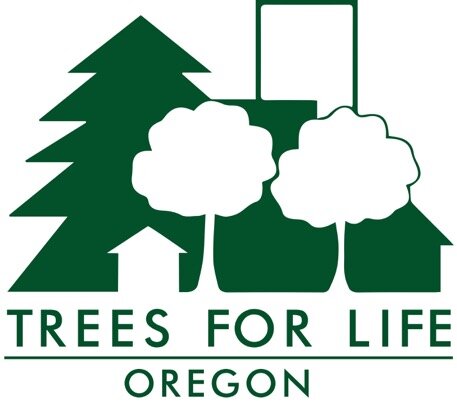Tree Policy Walk Along NE 102nd Avenue Spotlights Canopy Challenges
Bruce Nelson points out a gingko in a tree well. Photos by TFLO.
On September 24, 2022, TFLO’s Bruce Nelson led a tree policy walk along NE 102nd Avenue to highlight the challenges to protecting the little canopy that exists on and near East Portland’s major north-south corridors and to providing space to plant new shade trees. Neighborhoods near 102nd include Hazelwood, Powellhurst-Gilbert, Lents, and Parkrose Heights. Note that, citywide, the first three of these areas were among the top losers of canopy between 2014 and 2020, with Hazelwood leading the city with a loss of more than 3,100 trees. These areas are especially vulnerable to heat-island effects.
The event was part of a series of policy walks TFLO offered to the public in summer and fall 2022. (See a short video featuring the walk along 122nd Avenue.) The aim is to identify on-the-ground obstacles to expanding tree canopy, whose shade could help reduce the severe heat-island effects that residents and pedestrians along these streets face. The walks also demonstrated to participants some of the design and City code changes we’ve been advocating for that could, at a time of climate crisis, make low-canopy areas like East Portland more livable, now and into the future.
Kudos to the developer of this multi-unit lot along 102nd who chose to preserve this elm. Private property owners are not required to preserve large trees, yet with little space for big trees in rights-of-way, we need private shade trees now more than ever.
Portland City plans and documents tout environmental equity goals. But to reach those goals and accommodate large trees across town, the City and PBOT must rethink how they design streets, sidewalks, curbs, and commercial lot parking lots. Some positive examples already exist. Given adequate space to grow, large-form trees along arteries like 102nd can provide people walking and waiting for buses relief from noise, car fumes, and scorching summer heat.
Bruce Nelson, who initiated and conducted a volunteer-based street tree inventory of 82nd, 102nd, 122nd, and 164th avenues (his full findings will be published on our website this fall, together with a history of these corridors), found sparse canopy along 102nd and precious little tree diversity:
—Only 25 percent of 102nd Avenue’s tax lots contain street trees.
—Over 40 percent of these trees are ginkgoes, and 15 percent are ash. Lack of diversity leaves canopy vulnerable to species-specific diseases and pests such as the dreaded emerald ash borer, which arrived in Oregon this past summer.
—Most 102nd Avenue street trees don’t receive routine pruning to improve their structure and long-term health. This is not surprising, because Portland places the burden of street tree maintenance on the adjacent property owner. We hope that over time the City will assume this responsibility.
—Much of the street contains curb-tight sidewalks, leaving no space to plant street trees. Those planted in tree wells don’t have enough soil volume to thrive, and tree wells are often trash collectors along commercial corridors.
Small grated tree wells are not the answer.
Alternative design options can accommodate trees on highly trafficked streets citywide. For instance:
— Provide incentives for businesses to plant and care for street trees or to plant and care for trees on their private property immediately adjacent to the street.
—Create asymmetrical strips—on the side of the street with high-voltage power lines that don’t allow for big trees, make curb-tight sidewalks; on the other side of the street, if no high voltage wires are present, create 6- to 8-foot planting strips that can hold larger trees, creating one sufficiently shady side of the street for pedestrians.
—Widen tree wells as allowed by the newly adopted Pedestrian Design Guide. Tree well size is now recommended to be 9 feet wide. Most existing street-tree wells on 102nd are smaller.
—Extend curbs on some residential streets to create adequate planting space for large-form trees.
The City regulates street trees, which are in the public right-of-way. Too many trees on private property—which holds about half the city’s canopy—are lost during development due to inadequate tree protection requirements in the current tree code, Yet without such protections, and with little to no space for right-of-way trees along busy streets like 102nd Avenue, how is the City to reach its canopy equity goals?
Portland will be revising its Urban Forest Management Plan and Title 11 tree code over the next few years. But the time to speak out to preserve large-form trees and adequate space to plant new ones is never too soon!



